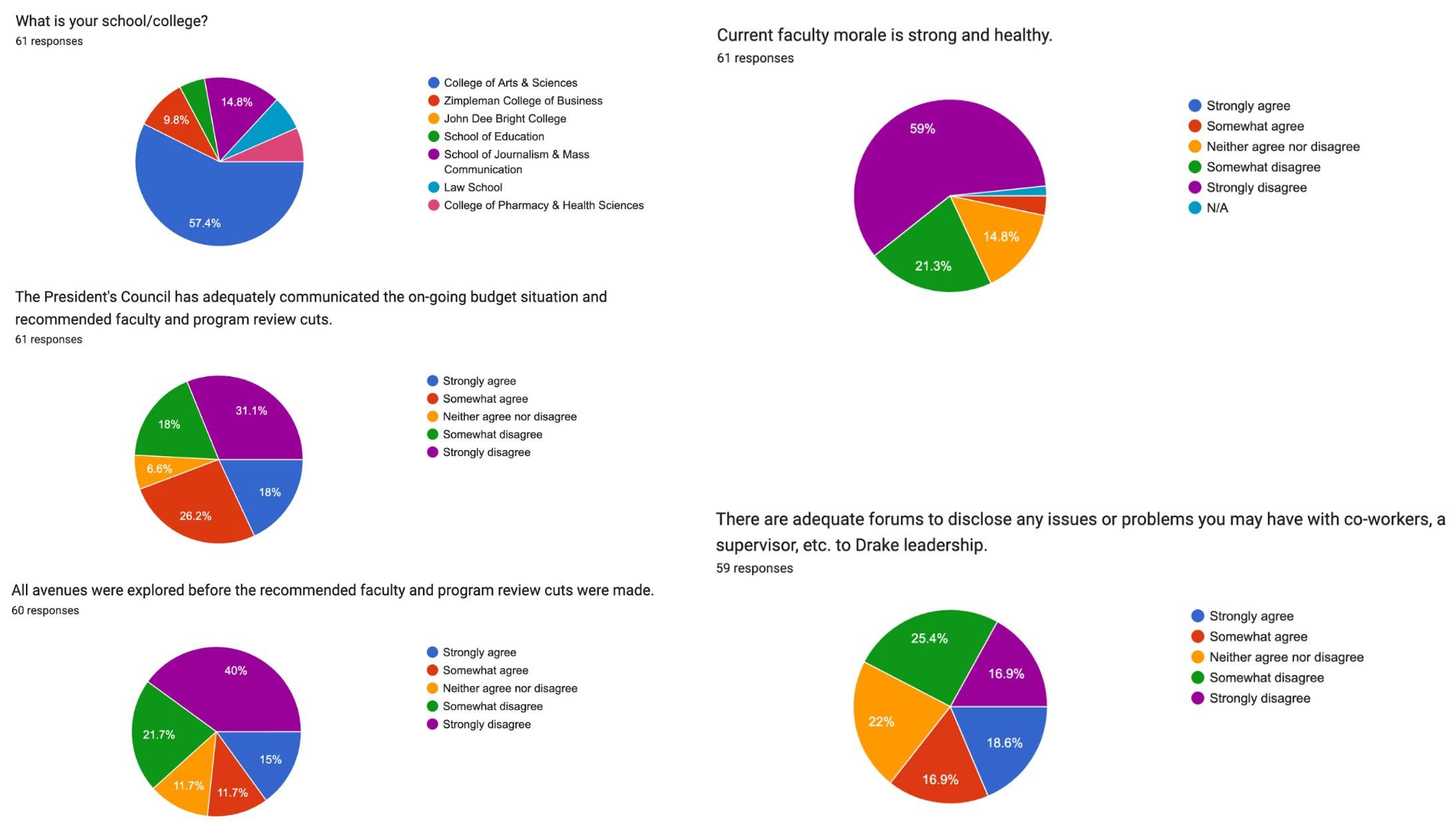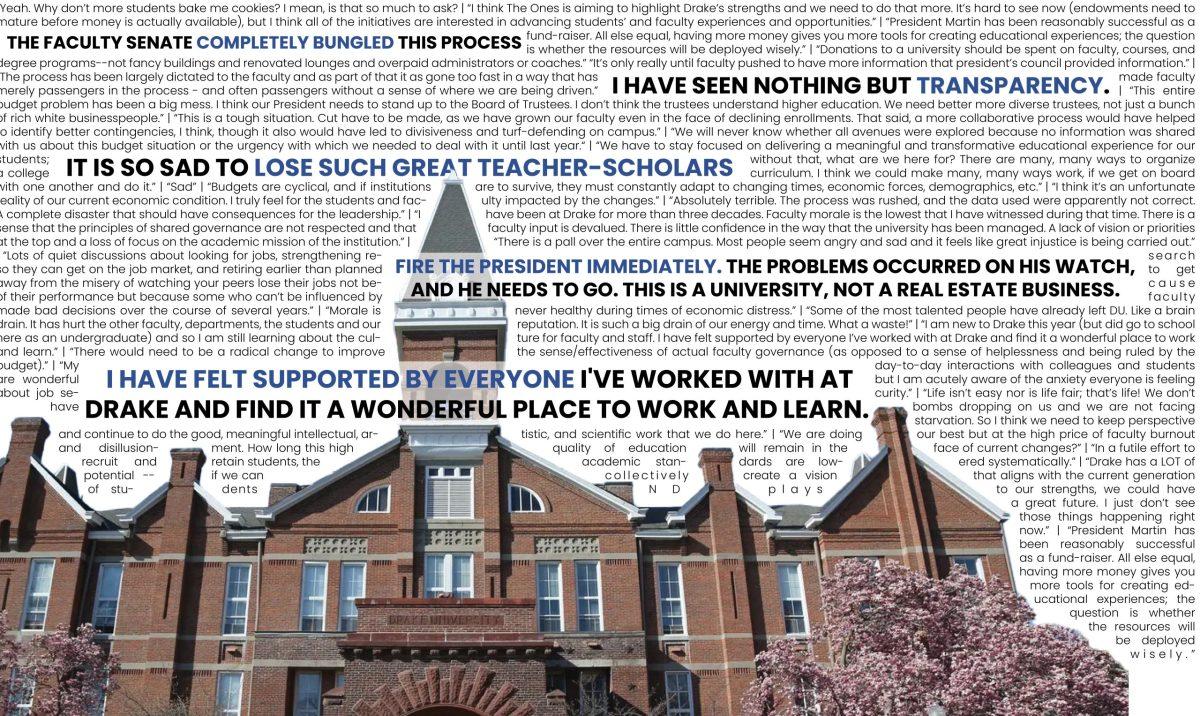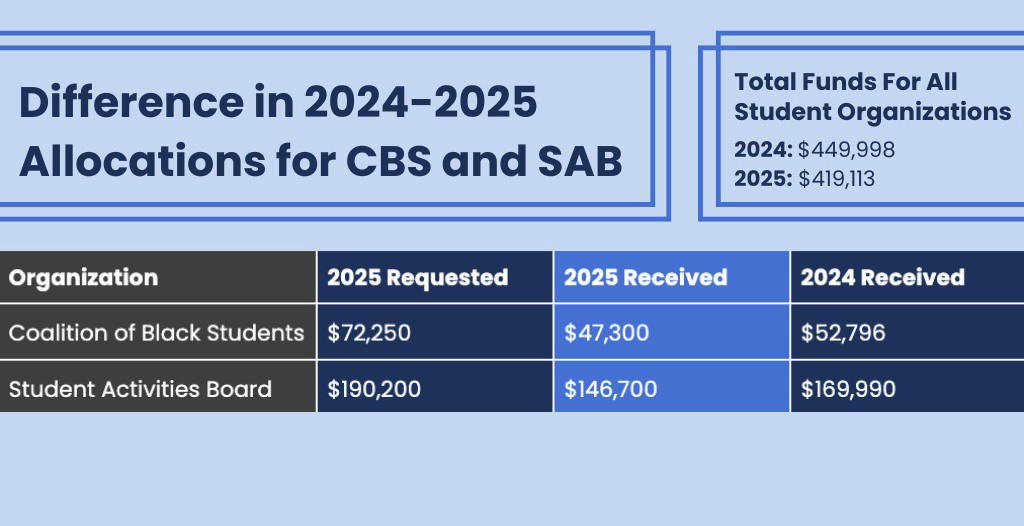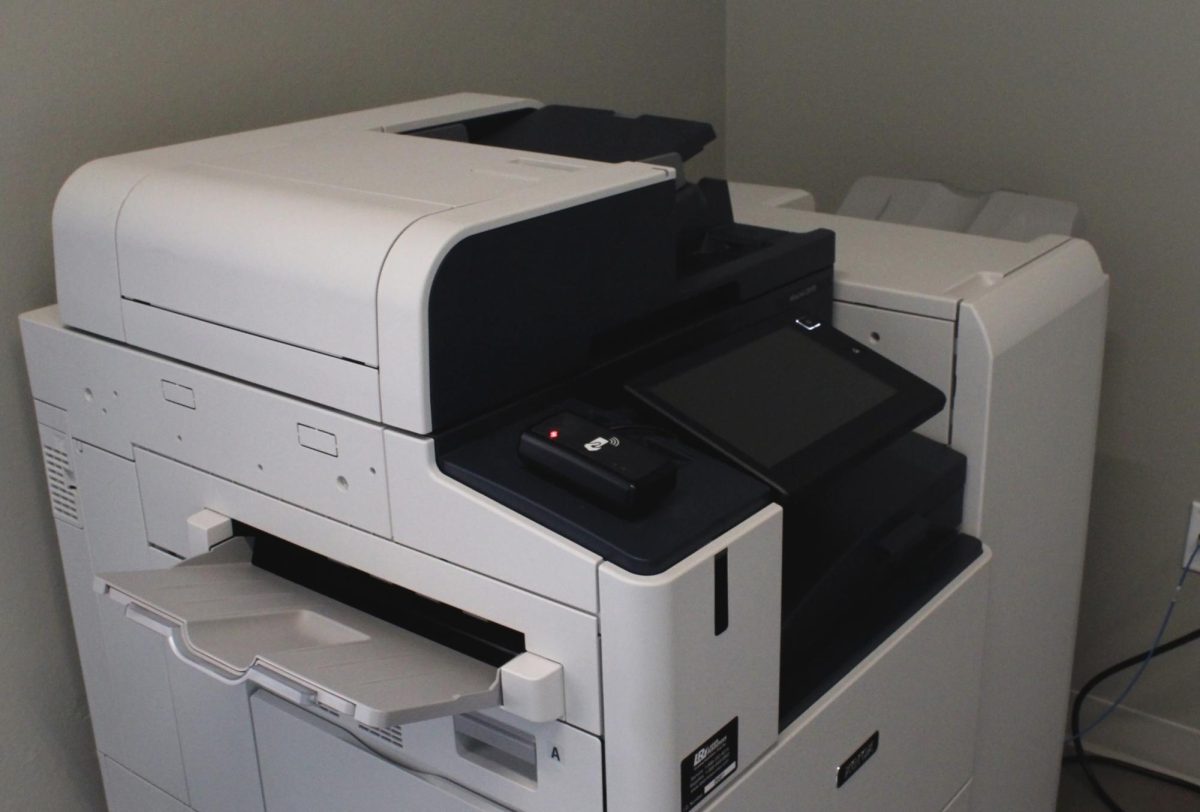Last year, The Times-Delphic started the tradition of sending faculty members an anonymous survey to learn more about general campus feelings. This year, the TD sent out the annual anonymous survey on March 25 and gave faculty two weeks to respond. Faculty members could stay anonymous, and all responses will be attributed as anonymous respondents in this article.
The TD’s survey questions were written with the current budget deficits and recommended program review cuts in mind as faculty members will be directly impacted by them.
Survey Demographics
A total of 61 faculty members responded from every college and school at Drake University. More than half of the survey respondents belonged to the College of Arts and Sciences. Almost 45% of respondents labeled themselves as full professors and 64% of respondents said they have tenure status. See figure 1 for more information.
Faculty respond to recommendations to eliminate programs
President Marty Martin said in an email on Thursday that the University will balance its operating budget by “fiscal year 2026.”
Faculty expressed mixed levels of agreement with the statement “The President’s Council has adequately communicated the on-going budget situation and recommended faculty and program review cuts.” See figure 2 for more information.
The President’s Council includes the chief administration officer, provost, chief financial officer and others.
One anonymous faculty member felt the council had not been “transparent” or “adequately considered all possible options” in regards to improving the budget.
“Why is one program being recommended for cuts but no faculty lines are being cut there? Where is the cost savings from that? The recommended cut will result in reduced revenue,” this anonymous faculty member said in the survey. “Why are the criteria being considered for cuts so one-dimensional? Are we only caring about enrollments now?”
Other faculty members reiterated this sentiment and said the transparency and communication — specifically around the proposed program cuts — has been, as one person said, “a big mess.”
Some faculty disagreed and felt that the council had been transparent or had communicated as well as they could have in a situation like this.
“I think [the] President’s Council has done a good job of conveying where we stand financially,” one faculty member said. “I feel that the program review process was not nearly as well communicated, and that it was not as collaborative [a] process as it should have been. There is a strong feeling among faculty that we had to do a lot of work to put together data for the review, and in the end they either did not use the data or relied on data we already communicated to them [as] faulty.”
About 60% of respondents said they either somewhat disagree or strongly disagree with the statement “all avenues were explored before the recommended faculty and program review cuts were made.” See figure 3 for more information.
“We will never know whether all avenues were explored because no information was shared with us about this budget situation or the urgency with which we needed to deal with it until last year,” one faculty member said.
Another anonymous respondent said it’s a “tough situation” as cuts “have to be made” because the faculty has grown even while the University faces declining enrollment.
“That said, a more collaborative process would have helped to identify better contingencies, I think, though it also would have led to divisiveness and turf-defending on campus,” that respondent added.
Philosophy professor Jennifer McCrickerd said the reason why certain programs were recommended for elimination has not been clear. One justification provided to faculty from Mattison as to why a program was recommended to be cut was based on the number of people majoring in a subject, according to McCrickerd.
However, she doesn’t understand why a low number of people majoring in a subject is a good reason to cut a program. Particularly for programs where “classes are constantly filling,” McCrickerd said it brings into question why University leadership paid more attention to certain metrics than others.
“My understanding was that you want to make sure that you’re offering classes that students want to be taking,” McCrickerd said.
Faculty in programs who felt their classes were “satisfying a demand from the students” may have felt “a false sense of security” that their programs were safe from elimination and may feel that their work “isn’t important,” McCrickerd said.
“[That our work isn’t important is] not anything that anybody has said,” McCrickerd said. “I strongly suspect that [Provost] Sue [Mattison] would say, ‘Oh, my God, that’s not what I’m saying.’ But that’s how it feels to people.”
Majority disagree that faculty morale is “healthy”
Based on the survey results, 59% of faculty members strongly disagreed with the statement that “current faculty morale is strong and healthy.” See figure 4 for more information.
McCrickerd said that the feelings of the faculty she has spent time with mirror the survey results
“They all love teaching, so there’s no question about that. But I don’t think if you asked anybody that they would say that they’re experiencing high morale,” McCrickerd said.
McCrickerd, who has been at Drake for almost 30 years, doesn’t think morale has ever been as low as it is now but acknowledged that, in the past decade, a lot has changed. As faculty, she said they’ve never been more aware of budgetary challenges or the efforts to recruit more students to Drake, something all of higher education has struggled with over the last few years.
The fact that Drake also had a new president and provost — Martin and Mattison — in that 10 year span also changed “everything.”
Comparing that transition to when a church gets a new pastor, McCrickerd said everything feels different, from the personality and the way the pastor interacts with the congregation to the priorities. People who attend that church may not realize that the church they were experiencing is not going to be the same one now.
“I think that there are ways in which Marty’s approach and Sue’s approach to things are different than what we were used to,” McCrickerd. “This isn’t to say that they’re necessarily worse, but they’re different.”
One big change that might contribute to faculty feeling a “disconnect” with Martin stems from the fact that, according to McCrickerd’s assessment, Martin’s personality is different from former President David Maxwell. McCrickerd said Martin is “very good at following the rules” and adheres to the rules in the “way that faculty governance is supposed to work.”
“Marty does what he’s supposed to do and doesn’t go beyond that, which is not necessarily a flaw,” she said.
However, this leadership style is different from Maxwell’s, as he and the previous provost had more of a “reciprocal” and “informal” relationship with the faculty as opposed to the more “official relationship” upheld by Martin and Mattison.
“It’s the difference between your flight attendant doing all the things that a flight attendant is supposed to be doing, and the flight attendant being particularly nice to you or talking to you a bit or something like that,” McCrickerd said. “…We’re used to having a much more casual, informal, experience where the president and the provost are really seeking to find out ‘What do the faculty really want going on?’”
Faculty discuss desired changes
Faculty named specific changes in the survey that would improve their morale and experience at Drake. Free parking, being able to disconnect from students, and more accessibility to administration and the Board of Trustees were some suggestions.
McCrickerd said the “disconnect” that exists between administrators and faculty is not “uncommon” between people who aren’t interacting with each other.
“I genuinely don’t know if anybody besides me thinks that there’s a problem on both sides,” McCrickerd said. “I think that everybody has their little camp, and everybody likes to make claims about what they’re doing.”
While it would be a years-long process, she thinks admin and faculty should do social things together and to get to know one another as “people” instead of “roles” whether that’s through informal get togethers like dinner, or a bi-weekly discussion between faculty and administration on “How can we change?” and “What can help us get to the next level?”
“I think Marty and Sue’s behavior – I don’t know if this is their intention – has led to them being viewed as their roles. And the consequence of that is that they’re perceived as not caring about anything else besides doing their job, and the rest of us are pretty much easily exchanged,” McCrickerd said. “If that’s what you think people’s attitude is, you’re not going to feel valued. But again, people draw conclusions based on not enough evidence because it fits into their story.”
Respondents express mixed feelings about the accessibility of Drake leadership
As to whether “there are adequate forums to disclose any issues or problems you may have with co-workers, a supervisor, etc. to Drake leadership,” faculty responses were mixed, with one faculty member responding just with “haha–whether they listen or not is an open question.” See figure 5 for more information.
Another respondent had similarly negative feelings.
“This administrative regime has done all possible to prevent faculty from communicating with each other about workplace concerns,” said one anonymous faculty member in the survey. They brought up the fact that the “reply all” functions and the ability to “email all” had been removed for faculty as examples.
Based on her personal experience with Martin and Mattison, McCrickerd has found them to be accessible, and that’s the sense she gets if others want to talk to them.
“But it also does seem to me, in the conversations that I’ve had, that there’s a very clear sense of, ‘Here is how it’s going to be done,’ and I’m trying to say, ‘But might it? Have you thought about doing it this way?’ [That] doesn’t really generate the sort of conversation that one might wish it does,” McCrickerd said.
Martin said in an interview that based on the feedback he received during the process of budget cuts, administration members created forums for faculty to discuss the budget cuts.
“People adapt and try to respond to what others need in order to feel appropriate about the process for going through,” Martin said.
Martin said that he disagrees with the sentiment that the administration is inaccessible. Martin said that, with his limited time and resources, he has tried to be as present as possible on campus.
The “Shaping our Future” website features a mechanism for faculty to submit feedback anonymously or non-anonymously, according to an email response the University sent to the TD.
“We welcome and encourage faculty members to bring forward their ideas — whether to their Faculty Senator, their Program Chair, their Dean or directly to the Provost or President. We all want what is best for this campus community and for the future of our wonderful institution, and we recognize that it’s the collective responsibility of everyone on this campus to bring forward ideas on how we can continue to improve,” the University response says.
Other faculty brought up a perceived University-wide scarcity mindset — defined by Cleveland Clinic as tunnel vision that focuses on what a person lacks — as something they believed would be beneficial to move away from.
“How can Drake be an exciting vibrant place to study and work if we always have to be worried about sinking financially, all while everyone feels like they’re underpaid because raises are so scarce?” said one anonymous faculty member in the survey.
Another faculty member wished the Board of Trustees would focus on the educational mission instead of cost-saving.
“Faculty positions are not problems to solve; they are our precious resource and must be valued as such. Then we work to cost-save,” this faculty member said in the survey.
Burnout in the education sector apparent at Drake
According to a training series by the National Institute for Occupational Safety and Health, burnout is an “occupational phenomenon” that can look different for everyone but usually includes fatigue. It usually comes from having too many demands but not enough resources to fill those demands.
Burnout is a major problem in the education sector, but according to a meta-analysis done by the National Institutes of Health, the COVID-19 pandemic increased burnout among teachers. Teachers showed a 52% rate of burnout, higher than levels found in nurses and healthcare professionals.
Many professors in the survey said that they felt high levels of burnout, while some said that burnout was characteristic of jobs today.
“We are so burned out there is nothing left to burn,” one anonymous faculty member wrote.
Professors in the survey noted the role the pandemic played in increasing burnout, including the stress of teaching online and later having to adjust to in-person teaching. Others mentioned an overload of work as a contributing factor.
The University response to the TD said that burnout is widespread in every industry. The University said they have compensated faculty for any overload work they completed and have implemented professional advising when necessary.
“It’s important to recognize the impact of challenges facing higher education on all of our roles, and how we must change as an institution to remain relevant, and ensure we are a strong university for future students and colleagues,” the University response said.
In terms of solutions, some noted that they wished there were an “unplugged” policy where professors were unreachable over weekends, more appreciation from leadership, or salaries that represented their work.
“Workload is not distributed evenly, so some faculty take on a tremendous amount of work with little opportunity for reward. It hurts their long-term academic career prospects (by devoting time to service rather than research or teaching),” one anonymous faculty member said. “The effort to equalize pay is particularly problematic on this front, as it ignores the differential workloads that faculty take on.”
Faculty salaries
Of the faculty members willing to disclose their salary — almost 30% preferred not to say — 28% make $50,000-$75,000.
When asked if their “salary reflects [their] labor,” faculty members were mainly split between “strongly disagree,” “somewhat disagree” and “somewhat agree.”
Of the 21 faculty members that elaborated, many felt that Drake lagged behind the market or in comparison to others with the same rank and field.
“My qualifications alone should earn me a higher salary. But beyond that, the fact that this is a 24/7 job with essentially no days off (and even though I’m on a nine-month salary, being asked to “volunteer” in the summer), I estimate that my hourly rate is under $20/hour,” a faculty member said.
Another faculty member said they’d have “zero issues” with their salary if there was an equal share of “departmental workload.”
“Departmental workload is not distributed equally, and varies at times by 30-40%, and hundreds of hours a semester,” that faculty member added.
After being asked if their salary is “enough to be able to live in Iowa comfortably,” many people said “yes” but with the caveat being that it was difficult to save for retirement, invest or to support a family.
The Ones
“The Ones” is a fundraising campaign that seeks to raise $225 million for initiatives such as the Morehouse renovations and scholarships. Professors in the survey spoke about “The Ones,” with some thankful for the money while others criticized the focus on buildings, wishing there was more focus on scholarship.
“It is nice to get donations for special projects on campus, but it doesn’t make sense to get big donations that commit the University to special plans while also not contributing a portion to the actual existence of the general mission of this school,” an anonymous faculty member said.

Quality of Education and Drake’s Future
According to the survey, about 42% of respondents said that they “strongly agree” that Drake maintains a high quality of education for its students, while 33% of respondents said “somewhat agree.”
One faculty member said that despite Drake creating too many programs that it couldn’t sustain, and in some cases not having enough classes for a program, the quality of education was strong.
“As a student, I did not experience the kind of care I see expressed daily at Drake. No one would have cared if I showed up to class or did not hand in assignments. People here care,” that faculty member said.
Many faculty brought up worries that budget cuts would impact the quality of education. Some faculty brought up deans asking them to lower course standards to boost student retention.
“We are doing our best, but at the high price of faculty burnout and disillusionment. How long [will] this high quality of education remain in the face of current changes?” one faculty member said.
Martin said that these budget cuts were a difficult but necessary point for Drake. Martin said colleges across the country were facing the enrollment cliff — a combination of declining population and fewer high school seniors being interested in college post-graduation.
“This is by far the most challenging time I’ve ever seen. And I think colleagues even who’ve been [here] longer would say the same thing,” Martin said. “COVID was episodic. We knew COVID would pass. This is not episodic. This is structural.”
To read about other faculty responses, visit timesdelphic.com








